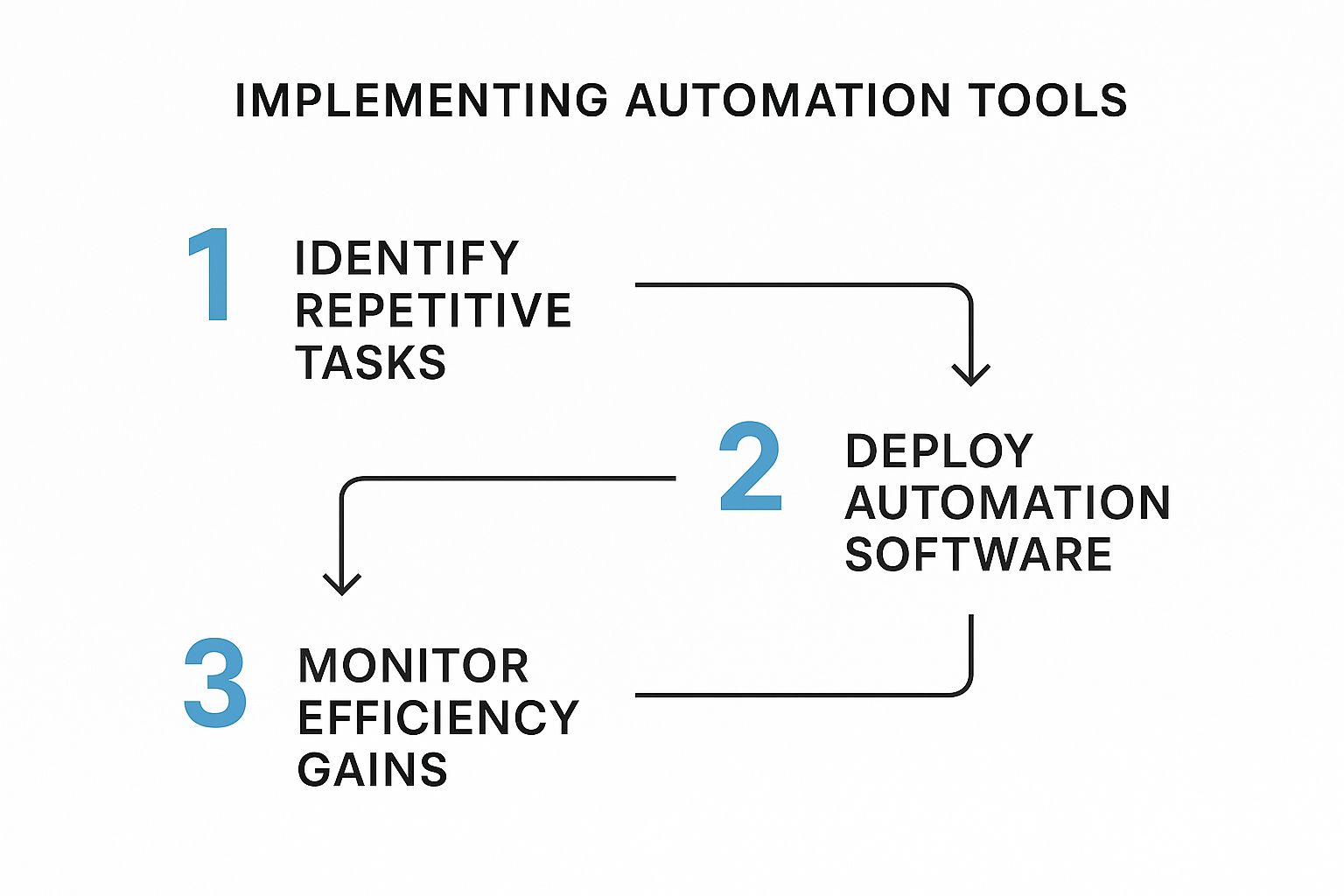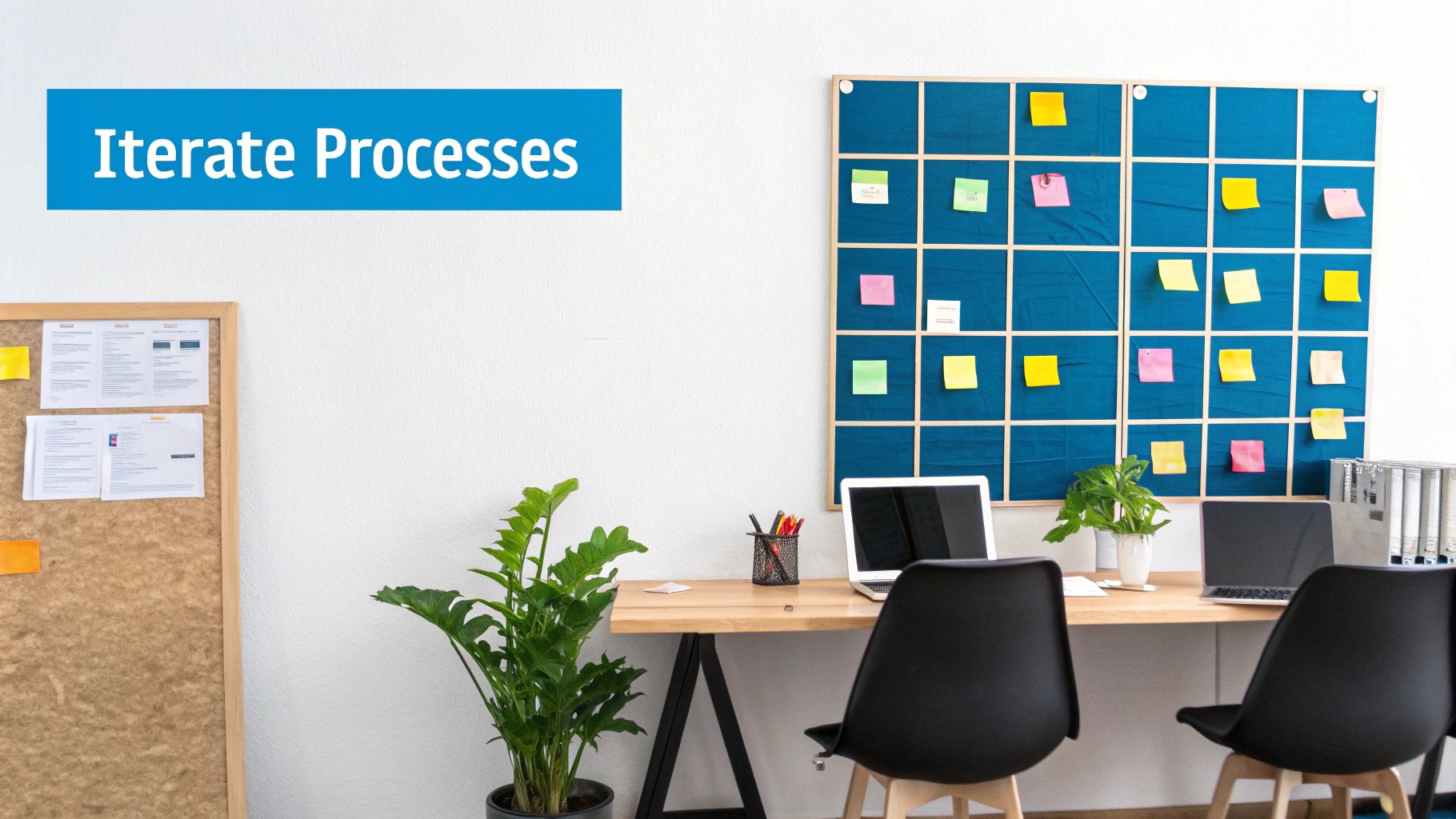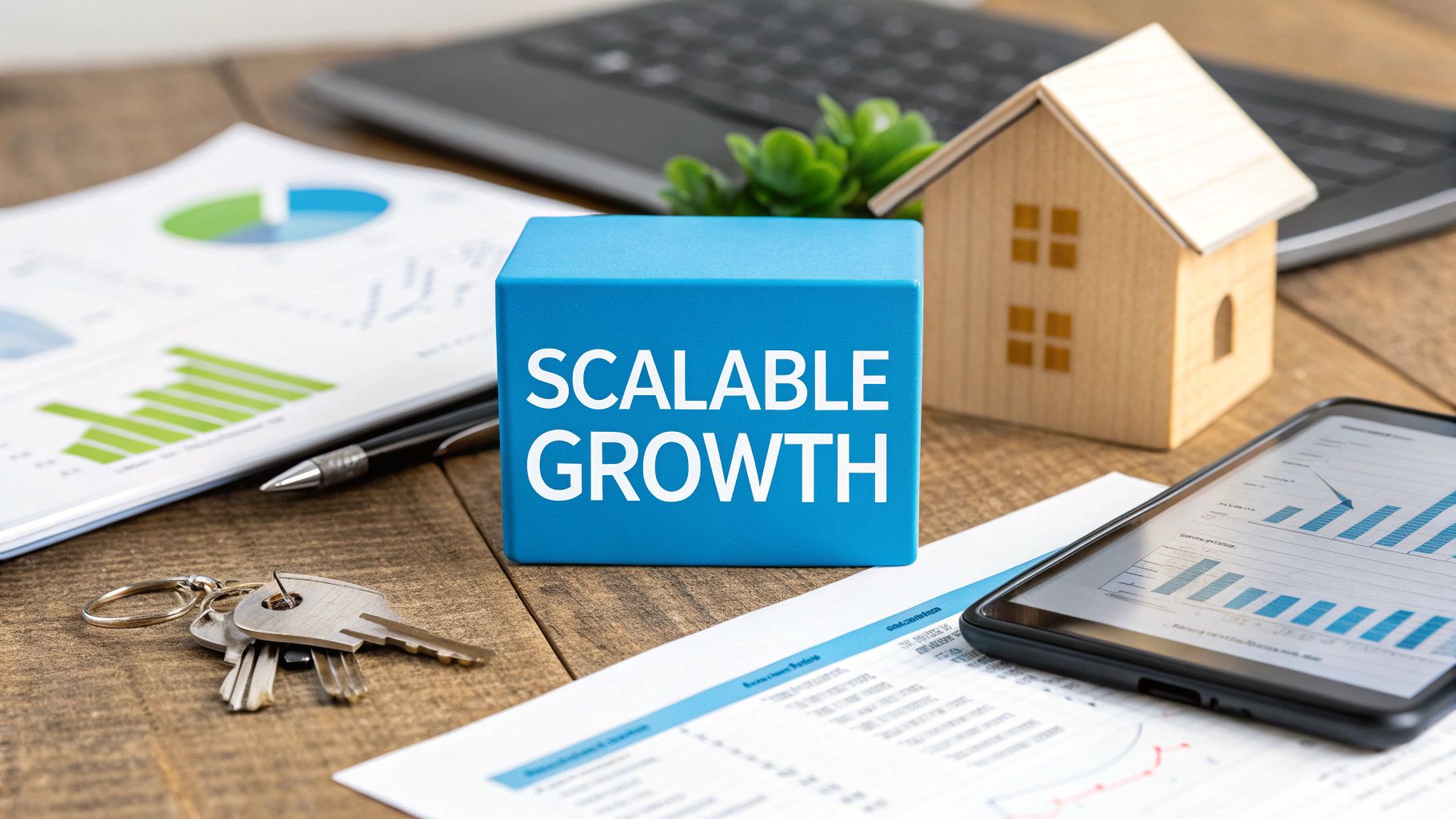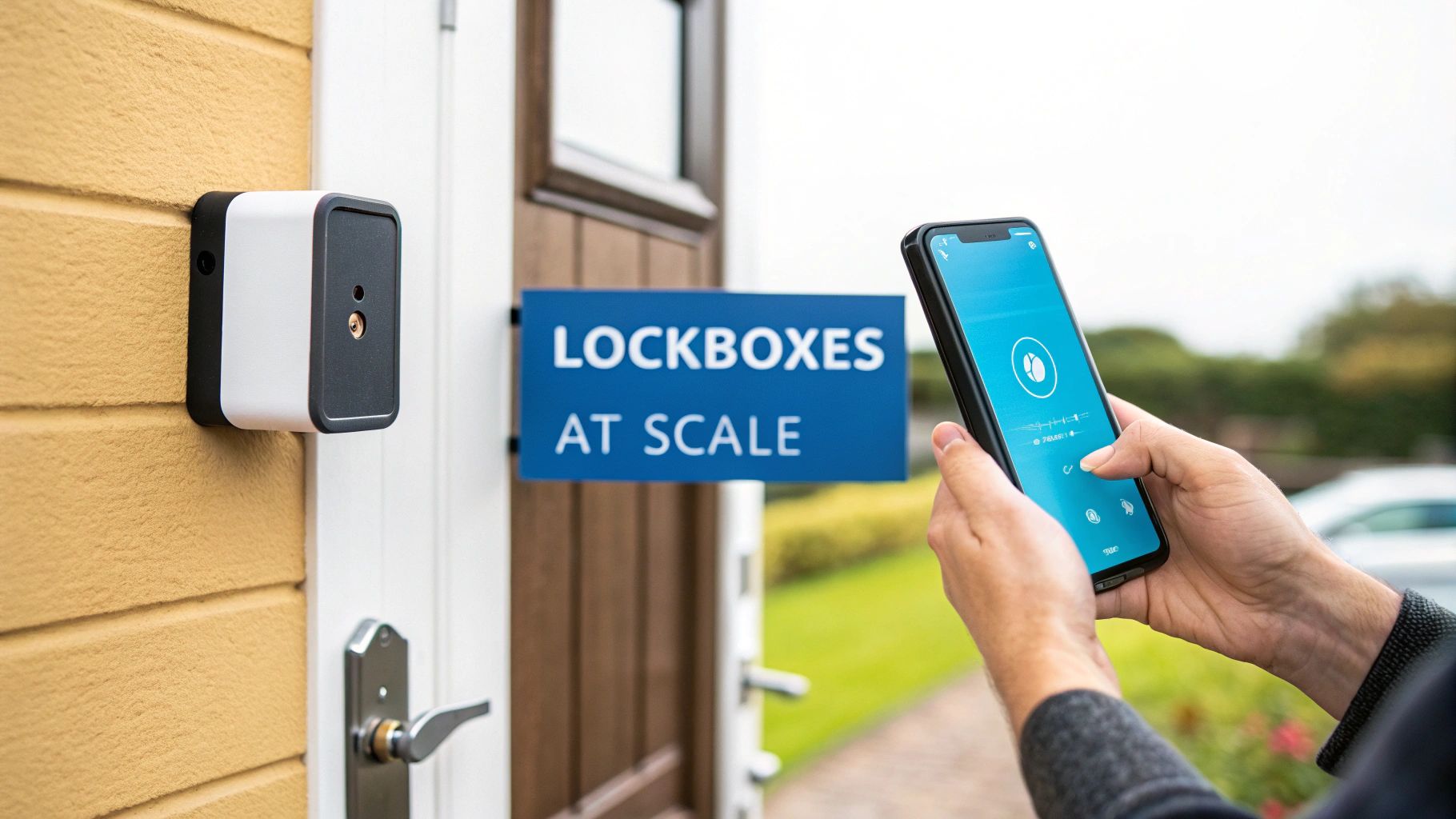If you want to make your property management business truly efficient, you need to look beyond just cutting costs. The real goal is to build a smarter, more resilient operation that delivers incredible service without burning out your team. This means moving from a constant state of "firefighting" to a proactive, controlled approach.
It all boils down to a clear, four-part strategy: auditing your workflows, using smart automation, tracking what matters, and creating a culture of constant improvement.
The Blueprint for Property Management Efficiency

Let's be honest, "operational efficiency" can sound like a lot of corporate jargon. In reality, it’s about building systems that do the heavy lifting for you, freeing up your team to focus on the high-impact work that actually grows your business and keeps tenants happy.
This isn’t just about buying the latest software. It's about fundamentally rethinking how you get work done. It requires a smart mix of technology and smoother processes. Think about it: even a small tweak, like increasing your team's billable time by just 2% through automation, can have a massive impact on your bottom line.
The Core Pillars of Efficiency
To build a genuinely efficient operation, you can't just tackle one thing at a time. It all starts with taking an honest look at your current processes. From there, you can bring in the right tools and foster a mindset that ensures these improvements stick around for the long haul.
Here are the foundational pillars you need to master:
- Workflow Audits: Dig into your core processes—from screening tenants to handling maintenance calls—to uncover hidden bottlenecks and time-wasting steps.
- Strategic Automation: Implement tools to handle the repetitive, low-value tasks like scheduling showings or sending rent reminders. This frees up your team for more strategic work.
- Data-Driven Tracking: Define and monitor your key performance indicators (KPIs). This is the only way to know if your changes are actually working and to make smart, data-backed decisions.
- Continuous Improvement: Build a culture where everyone on your team feels empowered to point out inefficiencies and suggest better ways of doing things.
When you master these areas, you create a powerful cycle: you spot a problem, implement a solution, measure its success, and then fine-tune it. This is how you stay agile and competitive.
The following table breaks down how these pillars work together to transform your operations.
Key Pillars of Operational Efficiency
This blueprint ultimately helps you shift from just managing properties to optimizing a business. It’s about building a scalable operation that’s built to thrive, not just survive.
To get started, it’s always helpful to see how other successful property managers have tackled this. You can get some great real-world examples by checking out our guide on achieving efficiencies in property management. In the next sections, we’ll break down each of these pillars with actionable steps you can take right now.
Find and Fix Hidden Workflow Bottlenecks
You can't fix what you can't see. If you really want to supercharge your operational efficiency, you have to become a detective within your own business. It’s all about uncovering the hidden friction points that quietly drain your team's time and inflate your costs. The first step? A simple, practical self-audit of your core workflows.
Don't try to boil the ocean here. Just pick one of your most critical, high-volume processes to start. Think tenant onboarding, rent collection, or the big one for most PMs: maintenance requests. The goal is to map out every single touchpoint, from the moment a tenant submits a ticket to the second that job is marked complete and paid for.
Tracing a Single Maintenance Ticket
Let’s follow the typical journey of one maintenance request. A tenant calls, and someone on your team jots down a note. That note gets turned into an email for the maintenance coordinator, who then has to pick up the phone and call a vendor. The vendor schedules a visit, does the work, and eventually sends over an invoice. Finally, your accounting team has to process the payment.
When you actually draw this out, the bottlenecks practically jump off the page:
- Redundant Data Entry: The same information gets typed out over and over—in a call log, an email, a work order, and then an invoice.
- Disorganized Communication: Critical details get buried in long email chains or are completely forgotten after a quick phone call.
- Scheduling Delays: The back-and-forth phone tag between the tenant, your team, and the vendor creates some serious lag time.
Each one of these moments is a hidden cost. It's not just about wasted payroll hours; it's also about the risk of frustrating a good tenant. Spotting these weak spots is the first real step toward making a meaningful change.
A study of UK office workers found that the average employee is only truly productive for 2 hours and 53 minutes per day. Getting rid of inefficient processes is how you reclaim that lost time and redirect it toward work that actually adds value.
This infographic breaks down a simple framework for moving from identifying the problem to implementing a solution.

As you can see, before you even think about new software, the real work starts with pinpointing those repetitive, time-sucking tasks.
Proactive vs. Reactive Fixes
Once you can see the bottlenecks clearly, you can finally shift from a reactive to a proactive mindset. Instead of just trying to speed up a broken process, you can redesign it from the ground up for pure efficiency. It’s a lot like property care—implementing preventative strategies in your operations helps you fix these hidden workflow issues before they snowball into major headaches.
For example, a common bottleneck is the manual follow-up needed just to confirm a vendor appointment. A proactive solution would be to set up an automated system that sends reminders to everyone involved, completely cutting out the need for those manual check-in calls. This small change alone can free up hours every single week, letting your team focus on more complex problems and boosting your overall operational efficiency.
Put Automation to Work in Your Daily Operations

After mapping your workflows and shining a light on those sneaky time-wasters, it’s time to let technology take over the grunt work. This is where automation stops being a buzzword and becomes a real, practical tool for your business. The goal isn’t to replace your team, but to get them out of the weeds so they can focus on what they do best.
Think about something as simple as lease renewal reminders. Right now, someone on your team is probably tracking dates, drafting emails, sending them out, and then chasing down non-responsive tenants. An automated system can run that entire sequence on its own, making sure nothing ever falls through the cracks.
By 2025, more companies will be using automation to kill manual data entry and repetitive tasks, freeing up their people for high-value strategic work. It’s not just about speed; automation also standardizes your service and cuts down on human error.
From Manual Grind to Automated Excellence
Leasing is usually the biggest time-suck in property management, packed with endless phone calls and emails. This is exactly where automation can deliver some of your biggest wins.
Imagine a prospect spots your listing at 10 p.m. on a Tuesday. Instead of waiting for your office to open, they can get an instant reply, answer a few pre-qualifying questions, and book a tour right then and there. A platform like Showdigs makes this possible without anyone on your team lifting a finger. That immediate engagement is a game-changer and dramatically shrinks the leasing cycle.
This approach gives renters a better experience and hands your team back their most valuable asset: time. Suddenly, they aren't drowning in scheduling conflicts. They’re nurturing qualified leads and closing deals. For a deeper dive, our guide on how to improve property management operations is full of practical steps.
The real magic of automation is how it shifts your team’s focus. When tech handles the mundane, your skilled people can pour their energy into building tenant relationships, negotiating smarter contracts, and actually growing the business.
Smart Systems for Maintenance and More
Automation is bigger than just leasing. Let’s look at your maintenance workflow. A smart system can take a tenant’s request, use keywords to figure out how urgent it is, and automatically assign it to the right vendor. No more middle-of-the-night calls for a leaky faucet.
Here’s what that looks like in the real world:
- Lease Renewals: Set up automatic emails and texts that fire off 90, 60, and 30 days before a lease is up.
- Maintenance Tickets: Create rules to auto-assign low-priority jobs (like a running toilet) to your go-to handyman, while high-priority issues (like a major pipe burst) are immediately escalated to your emergency plumber.
- Showing Schedules: Use on-demand agent networks to cover property tours, so you never miss a lead because your team is stretched thin.
This isn’t unique to property management. Other industries have been improving efficiency with integrated fleet software for years to manage vehicles and maintenance. The core idea is the same: build systems that do the work for you.
Measuring What Matters for Real Growth
So, you’ve started automating the repetitive, time-sucking parts of your operation. That’s a huge win. But how do you prove it’s actually working?
If you can’t measure it, you can’t manage it. It's time to move beyond guesswork and gut feelings. To really scale, you need a data-driven approach grounded in Key Performance Indicators (KPIs) that tell the true story of your business's health.
This isn’t about getting lost in a sea of spreadsheets. It's about zeroing in on the numbers that paint a clear picture of your efficiency, profitability, and tenant happiness. This data becomes your secret weapon, helping you justify new tools and prove the ROI of your process improvements to owners.
Essential KPIs for Property Management
For property managers, a handful of core metrics can give you a powerful, at-a-glance snapshot of your operational performance. Instead of drowning in data, start by tracking these critical numbers:
- Vacancy Turnaround Time: This is the number of days a unit sits empty between tenants. Every single day costs money. A high number here is a red flag, pointing directly to bottlenecks in your make-ready process or leasing workflow.
- Cost Per Maintenance Work Order: Tracking the average cost of maintenance requests helps you get a handle on your repair expenses and spot trends before they become major problems. Are certain vendors consistently over budget? Are you seeing a spike in a specific type of repair that points to a bigger issue?
- Tenant Satisfaction Score: A simple survey can tell you volumes about tenant happiness. This is a crucial leading indicator of retention. Happy tenants are far more likely to renew their leases, saving you the immense cost and headache of turnover.
The ultimate goal is to connect these numbers to your actions. For example, after implementing an automated showing schedule, you should see a measurable decrease in your Vacancy Turnaround Time. That’s how you prove your strategy is working.
When measuring what truly matters for real growth, optimizing your leasing process is a critical step to maximize conversions and operational effectiveness; consider these strategies for sales funnel optimization to further enhance your results.
A few key metrics can transform how you see your business. Here’s a quick breakdown of what to track and why it’s so important for your bottom line.
Essential KPIs for Property Management Efficiency
Keeping a close eye on these numbers shifts your entire operation from reactive to proactive, allowing you to make smarter, more profitable decisions.
The Power of Data in Decision Making
This data-first mindset is what separates struggling property managers from the ones who are scaling successfully. The proof is in the numbers.
One forecast predicts the global workflow automation market will surge to $80.9 billion by 2030. It’s not just hype; research from McKinsey shows that two-thirds of companies have seen real improvements in quality, customer satisfaction, and lower operating costs after embracing automation. You can find more details on these automation statistics at VenaSolutions.com.
For your property management business, this translates into real-world benefits. By tracking your KPIs, you can finally answer those critical questions with confidence: Did our new tenant portal actually reduce the number of phone calls? Did the automated renewal reminders boost our retention rate?
This approach moves your decision-making from subjective opinion to strategic certainty. You’ll know that every change you make is directly contributing to a healthier, more profitable business.
Building a Culture of Continuous Improvement

Getting your operations dialed in isn't a one-and-done task you can check off a to-do list. The real, lasting gains come from building a culture where getting better is just part of the daily routine. It's about shifting the mindset across your entire team so that efficiency becomes a shared goal, not just another directive from the top.
This shift starts with creating simple, effective ways for your team to give feedback. Your people on the front lines—the leasing agents, maintenance coordinators, and property managers—are the first to know when a process is clunky or just plain broken. Give them an easy, direct line to voice their observations and suggest improvements without worrying about being critical.
Empower Your Team as Efficiency Experts
Your people are your best resource for sniffing out waste. They’re the ones wrestling with clunky software features or dealing with communication breakdowns that cause constant delays. They know where the friction is.
To tap into that firsthand knowledge, you have to genuinely empower them. This doesn't have to be complicated. It could be as simple as a dedicated Slack channel for process ideas or adding a "workflow wins" segment to your weekly meetings.
When a team member's idea for tweaking the work order approval process saves everyone five hours a week, celebrate it. Shout it from the rooftops! That kind of recognition validates their input and inspires everyone else to start looking for opportunities.
Empowering your team to spot and solve problems is the bedrock of a proactive culture. When people feel a sense of ownership over their workflows, they stop just doing their jobs and start actively improving them.
Establish a Rhythm for Review
To keep the momentum going, you need a regular cadence for reviewing your processes. Think of it as a team huddle. Quarterly check-ins are a great way to create a dedicated time to look at what’s working, what’s not, and how you can get ahead of new challenges.
These reviews should be driven by data but focused on people.
- Talk About the Numbers: Dig into your KPIs. Is your time-to-lease getting shorter? Have maintenance costs leveled off?
- Get a Feel for the Ground: Ask your team directly. Where are the biggest headaches right now? What new ideas have popped up since your last chat?
- Look to the Horizon: What’s coming next? Are tenant expectations changing? Are new compliance rules on the way?
This proactive rhythm prevents your operations from ever getting stale. It turns your business into a nimble organization that is constantly learning and refining its game. That commitment doesn't just make you more competitive—it flows directly to your bottom line. For more on this, check out these 8 ways to boost your property management ROI.
Your Top Questions About Operational Efficiency, Answered
Jumping into operational improvements can feel like a huge undertaking. It’s totally normal to have questions about where to even begin, what it's going to cost, and how your team will handle the changes. Let's tackle some of the most common questions we hear from property managers.
Where Should I Start Improving Efficiency on a Tight Budget?
You don't need to throw a ton of money at the problem to see real results. The secret is to start small and aim for a high-impact win.
Pick just one critical workflow that’s a constant headache—maybe it's processing maintenance requests or handling new leads. Map out every single step from start to finish. Where’s the biggest bottleneck? Is it disorganized communication? Scheduling delays?
Often, a simple, free tool can plug the gap. Something as basic as a dedicated Slack channel for maintenance or a shared Google Calendar for vendor appointments can work wonders without costing a dime. The goal is to get one small, visible win. This builds momentum and gives you solid proof that your ideas work before you go asking for a bigger budget.
How Can I Get My Team on Board with New Processes?
Nobody likes having change forced upon them. The key to getting buy-in is to make your team part of the solution, not just the recipient of a new directive.
Instead of dropping a new tool on them out of the blue, present the problem. Say something like, "Look, we're all spending way too much time manually entering lead info, and it’s causing us to lose good prospects."
Then, ask for their input. What are their biggest frustrations with the current process? What do they think would help? Frame any new tool as a way to make their jobs easier—not to micromanage or replace them. Focus on the real-world benefits, like "no more confusing email chains" or "an end to weekend calls for showing requests." Follow up with great training and be sure to publicly celebrate the people who adopt it first. It creates a positive buzz and encourages everyone else to jump in.
The biggest mistake you can make is automating a broken process. If your current workflow is confusing, inefficient, or full of unnecessary steps, technology will only help you do the wrong thing faster. You’ll just end up with a fast, broken system.
Before you spend a dollar on software, you have to simplify the manual process first. Clarify who does what, get rid of redundant steps, and make communication crystal clear. Only then should you bring in automation to pour gas on that fire.
How Often Should I Review Our Operational Processes?
Finding the right rhythm for reviews is crucial. You don't want to be constantly changing things, but you also can't "set it and forget it." A balanced approach works best. Think about doing a major review once a year, with smaller, more informal check-ins every quarter.
- The Annual Review: This is your deep dive. Take a hard look at the big, complex operations like your entire leasing funnel, tenant turnover procedures, or vendor management.
- Quarterly Check-ins: These are quicker and more agile. Use them to make small tweaks based on recent performance data, team feedback, or any new challenges that have popped up.
This approach keeps your operations from getting stale and ensures you’re always adapting. It stops old, inefficient habits from creeping back in and keeps your business sharp.
Ready to stop wrestling with leasing bottlenecks and start closing deals faster? Showdigs automates your entire leasing funnel, from initial lead response to scheduling and conducting tours. See how our AI-backed platform and on-demand agent network can dramatically improve your operational efficiency. Explore Showdigs today.







